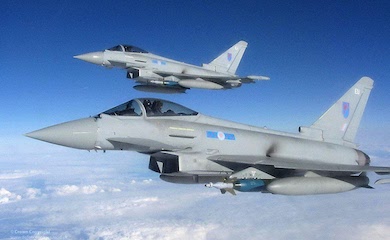Air Defence Radar were developed to identify aircraft amongst all other reflecting objects. To do this the radar first emits radar pulses at a known frequency, then detects whether they are returned at the same frequency. If they aren’t, the aircraft returning the signal is moving towards or away from the radar. This is a use of the ‘Doppler effect’.
Effect of Wind Turbines on Radar
Wind turbines are tall structures with a large Radar Cross Section (RCS). Their rotating blades move at speeds similar to some aircraft that most Doppler radar are designed to detect. This causes them to show up as targets, or returns, on the radar screen.
These wind turbine returns display intermittently. This further exacerbates the problem for radar operators especially when multiple wind turbines are situated close together, all painting intermittently in a random manner on the radar screen.
Radar ‘Clutter’
Displayed unwanted items, known as ‘clutter’ can appear on a radar screen constantly or occasionally. The shapes can vary depending on equipment design and the nature of the clutter source.
With respect to aerial navigation, clutter from a variety of sources occurs regularly in various areas on a typical radar screen. It is part of the radar operators’ role to understand and manage this clutter.
Some common sources of clutter detected and displayed by Doppler processing techniques include waves, clouds, precipitation, trees moving in wind, road traffic, boats and ships, birds and insects, and wind turbine blades.
Desensitisation
The main technical issue for Air Defence radar is overhead obscuration (also known as desensitisation), whereby due to the large wind turbine RCS compared to most target aircraft, combined with the radar’s data processing mechanism Air Defence radar lose sensitivity to such an extent that they cannot resolve small aircraft targets at any level above a wind farm.
Technical Mitigation – TPS-77
A technical mitigation option that has resulted in the removal of wind turbine Air Defence Radar objections is the use of Lockheed Martin TPS-77 Radar.
2012 UK Update
In a press release in 2012, the UK Ministry of Defence (MOD) installed and tested a Lockheed Martin TPS-77 near Cromer, on the Norfolk Coast. It was expected to allow the development of more than 3GW of wind energy. Also, the MOD ordered two more of the TPS-77 to replace existing Air Defence Radar in Northumberland and Yorkshire. This had the potential to remove objections for up to 0.75GW of wind energy.
We offer aviation and radar studies that can help you avoid MOD and other aviation stakeholder objections. Visit our services page for more information here…



